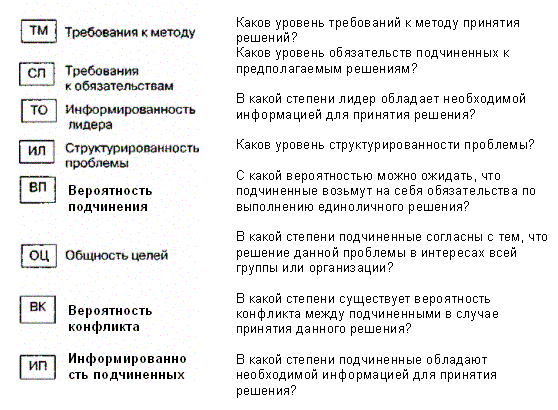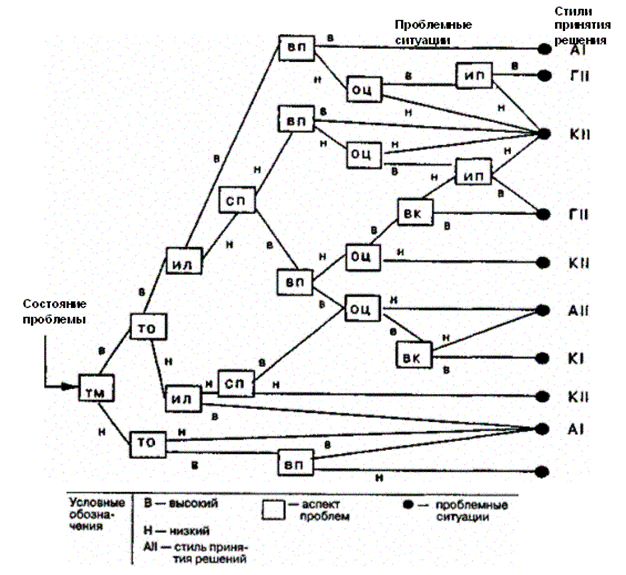home
 Management Management
 Management - Vikhanskiy OS Management - Vikhanskiy OS
|
Management - Vikhanskiy OS
3.6. Situational decision-making model of Vroom - Yetton - Iago
One of the most modern in explaining situational leadership is the model proposed by Victor Vroom and Philippe Yetton, which was later significantly supplemented with the participation of Arthur Iago [19]. Similarly to the "path-target" model, this model suggests defining an effective leadership style, depending on the situation. It is also assumed that the same leader can use different styles. The main difference of the model is its orientation to only one aspect of leadership behavior - the involvement of subordinates to participate in decision-making. Accordingly, the leader is invited to focus on the problem that needs to be solved, and the situation in which the problem has arisen. It is also implied that a number of social processes can influence the level of participation of subordinates in solving problems.
The main idea of the model is that the degree or level of involvement of subordinates to participate in decision-making depends on the characteristics of the situation. In accordance with the model, there is no one single right way to make a decision, suitable for all situations. After analyzing and evaluating each aspect of the problem, the leader determines which style, from the point of view of the participation of subordinates in the decision making, it is better to use.
In the model under consideration, the effectiveness of the solution (Reff) is determined on the basis of an equation showing that it depends on the quality of the solution (RACH) and the level of obligations taken by the subordinates to implement the decision (Robaz), and also on the degree of urgency of the decision (Time). The prerequisite of the model is the idea that the time allotted for solving the problem along with the other two is a critical factor. The situation in which the time limit does not play a role determines this index at the zero level.
Рэфф = Ркач + Робяз - Рвремя
The full criterial basis of the "overall effectiveness of the solution" (Oeff) involves taking into account the factors of "value" and "development" in it:
Oeff = Reef - Cost + Development
In the above formula, "cost" means a time lost due to the decision, which in another case could bring more benefit. The indicator "development" reflects the winnings that are received outside of the single-handedly taken decision.
The latest developed version of the model suggests the use of a decision tree to determine the leadership style that best suits the situation. When using the model, the manager, as it were, follows the branches of this tree from left to right. By doing this, he faces ten problematic situations.
The assessment of situations is done by him on eight aspects of the problem with a choice for each of them: high / high or low / low. These answers lead the manager to a specific problem situation and the recommended decision style for it (Figure 11.17).
Aspects of the problem

In order to make decisions in the model, it is proposed to use five styles depending on the situation and the degree of involvement of subordinates : autocratic I (AI), autocratic II (AN), consultative I (KI), consultative II (CI), group, or joint II (GN) . Each of these styles for group management means the following:
AI. The manager makes the decision himself using the information available to him for the time being.
AI. The manager receives the necessary information from his subordinates and then makes his own decision. Employees are involved only at the information gathering stage. The decision is made and adopted by the head.
KI. The leader on an individual basis shares his views on the problem with the subordinates who have an attitude towards it in order to obtain ideas and suggestions from them, without collecting them in the group. Then he makes a decision, which can be based on the contribution of subordinates, and maybe not.
KP. The manager shares his thoughts on the problem with his subordinates, collecting them together. During the meeting, he collects their ideas and proposals. Then he makes a decision that can either reflect or not reflect their contribution.

Fig. 11.17. The decision tree of Vroom - Iago
GP. The manager shares his thoughts on the problem with his subordinates, collecting them in a group. They work with him to develop and evaluate alternatives and try to reach a consensus on the solution. The role played by the manager is more like the role of the chairman of the meeting, coordinating the discussion, concentrating on the problem and doing everything to consider the most important aspects of the problem. The leader does not attempt to influence the group so that it takes its decision, and is willing to accept and execute any decision that has received the support of the whole group. In the early version of the model there was a style of P. However, later it was excluded, since it differed little from the GP style .
One of the distinguishing features of the model is that, on the whole, it places more emphasis on the study of the situation than on studying the personality of the leader. Indeed, maybe it makes more sense to talk about an autocratic situation and participation situation than about an autocratic leader or a participating leader.


Comments
When commenting on, remember that the content and tone of your message can hurt the feelings of real people, show respect and tolerance to your interlocutors even if you do not share their opinion, your behavior in the conditions of freedom of expression and anonymity provided by the Internet, changes Not only virtual, but also the real world. All comments are hidden from the index, spam is controlled.